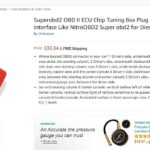On-Board Diagnostics II (OBD2) regulations are crucial for ensuring vehicles meet emission standards and for facilitating effective vehicle repair. These regulations, particularly those originating from California, often set the benchmark for automotive standards across the United States and beyond. Staying informed about the latest updates to Obd2 Regulations is essential for automotive professionals, manufacturers, and anyone involved in vehicle maintenance and repair. This guide provides an overview of recent OBD2 regulatory updates, primarily based on the standards set by the California Air Resources Board (CARB). For the most current and official versions, always refer to the Barclays Official California Code of Regulations.
Advanced Clean Cars II Regulations (2022)
The Advanced Clean Cars II regulations, approved by the Office of Administrative Law (OAL) on November 30, 2022, represent a significant step forward in emissions control. These regulations, effective immediately upon approval, include amendments to the existing OBD II framework to align with the new Low Emission Vehicle IV emission standards. This update is critical for manufacturers as it sets stricter requirements for vehicle emissions, pushing for cleaner and more environmentally friendly vehicles. Detailed regulatory documents pertaining to these changes can be found on the official CARB regulatory website.
OBD II and Heavy-Duty OBD Regulatory Updates (2021)
In 2021, further updates to OBD II and Heavy-Duty OBD (HD OBD) regulations were established. The final rulemaking package for these updates received OAL approval on November 22, 2022, also taking effect the same day. This regulatory action underscores the ongoing evolution of emission standards and diagnostic requirements for both light-duty and heavy-duty vehicles. For professionals needing to delve into the specifics, the official CARB regulatory website hosts all relevant documents, including notices and board hearing materials related to this 2021 update.
Heavy-Duty OBD and OBD II Amendments (2018)
Amendments introduced in 2018 impacted both Heavy-Duty OBD and OBD II regulations. These changes, affecting sections 1971.1, 1971.5, and 1968.2 of title 13, CCR, were aimed at further refining diagnostic system requirements. Professionals seeking detailed information can access the regulatory documents on the Heavy-Duty OBD Regulations and Rulemaking website or the main official CARB regulatory website. These resources provide valuable insights into the specific changes and their implications for vehicle diagnostics and repair procedures.
OBD II Regulatory Documents (2015)
The 2015 OBD II regulatory updates, finalized with OAL approval on July 25, 2016, brought about important modifications to the OBD II standards. The approved regulation orders, including “track changes” versions, clearly highlight additions and deletions from the previous regulations, making it easier to identify specific alterations. The official CARB regulatory website serves as a repository for all documents related to the 2015 update, including the Final Statement of Reasons Package and workshop materials.
Conclusion
Staying current with OBD2 regulations is not just about compliance; it’s about ensuring accurate diagnostics and effective repairs in an evolving automotive landscape. California’s OBD2 regulations often lead the way for national standards, making it crucial for automotive professionals across the US and beyond to monitor these updates. By utilizing the official resources provided by CARB and OAL, professionals can ensure they have the most accurate and up-to-date information, enabling them to provide the best possible service and maintain compliance with the latest emission standards.
